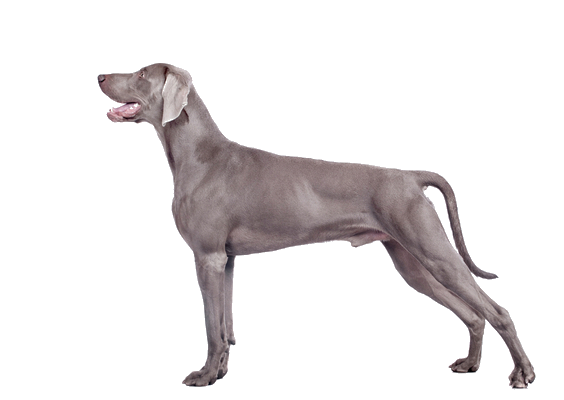Sporting Group
Naturally active and alert, Sporting dogs make likeable, well-rounded companions.
These all-purpose sporting dogs have a royal lineage. The Weimar royals, in what is now present-day Germany, prized Weimaraners for their hunting abilities. With tons of energy, a resilient body, and a loyal affection, the Weimaraner is a great dog for someone with an active lifestyle. They can be a bit difficult to train, but a properly socialized Weimaraner is an exceptional companion for anyone.
Origin: Germany Other Names: Weim, Weimaraner Vorstehhund, Grey Ghost
Naturally active and alert, Sporting dogs make likeable, well-rounded companions.
Dog breeds in the Sporting group are usually remarkable for their instincts in water and woods, and many of these breeds actively continue to participate in hunting and other field activities. Potential owners of Sporting dogs need to realize that most require regular, invigorating exercise.

A few things typically stand out when you first lay eyes on a Weimaraner. The first is their coat –the smoky blue, gray, or silver gray coat has a beautiful shade. Short fur highlights their muscular and powerful body. Ears frame a curious and wise face, but the next thing you’ll likely notice is their eyes. Whether they are blue, gray, or light amber, the Weimaraner’s eyes are deep and brilliant against their fur. This is an impressive-looking animal with a loyal following and growing popularity.
The AKC recognizes three standard colors: gray, blue, and silver-gray. There are no standard markings for Weimaraners in competition.
Weimaraners are a medium-sized breed. The adult males typically weigh between 65-85 pounds, and they grow to be roughly 22-28 inches tall. They aren’t huge dogs, but they have a stout muscular frame and long lanky legs.
| Full Grown | |
|---|---|
| Female | 23 in. / 65 lbs. |
| Male | 28 in. / 85 lbs. |
Height is measured up to the shoulders.



Weimaraners are a medium-sized breed. They have a stout, muscular frame and long, lanky legs. Adults grow to be roughly 22-28 inches tall.
Weimaraners are a medium-sized breed. Adults typically weigh between 65-85 pounds.
The Weimaraner isn’t a large dog, but they need some running room to be happy and healthy. If you don’t have a decent fenced-in backyard, you should expect to spend extra time at the dog park or out for long walks. Weimaraners have a lot of energy, and it’s up to you to help them burn it off every day.
Like most sporting dogs, the Weimaraner has an endless supply of energy. They are willing partners on long excursions into nature. Bred as hunting dogs, these energetic Weimaraners are game for whatever you throw at them. If you lead an active lifestyle, this might be the breed for you.
Weimaraners typically grow close to their immediate family, but they can be standoffish with strangers. When you add animals to the picture, they can be downright rude. The high prey drive and hunting instinct inherent in the breed can create awkward social situations. If you have cats or other small animals in your household, you might reconsider your choice of dog breed. The Weimaraner is a hunting dog, through and through.
Weimaraners are naturally curious and a bit suspicious of strangers. If it looks like prey, they are happy to pounce to take care of the problem. Larger intruders will be met with barks and some suspicious looks.
This breed is generally a good choice for a family without other pets. Weimaraners can bond very tightly with their human family, including the little ones. As with any dog, always monitor your dog with children, especially new friends and anyone not used to proper dog handling methods.
Weimaraners can be slightly difficult to train, but they are eager to please their owners. It’s important to develop their skills and obedience early in their life. Exposure to different people, places, and situations will help to build their confidence. It’s easy to learn about the proper training methods if you do a bit of research. Use positive reinforcement and lots of patience during training, and you’ll be rewarded with a loyal and faithful companion.
They aren’t prolific shedders, but your new Weimaraner may surprise you with their excessive shedding. Especially around the change of seasons, these little hair factories can create havoc without the proper intervention. Invest in proper tools such as grooming gloves, specialized brushes, and a strong vacuum.
Prized as great hunting partners, the Weimaraner is a sturdy and resilient outdoor companion. Aside from extreme cold or heat, they can manage just fine on a cool wet day in the fields. Always keep an eye on your dog for signs of distress.
Without causing you too much anxiety, you should know that these dogs are well known for excessive and loud barking. With proper socialization and minimal time alone, you can mitigate their chatty nature. If you need a quiet and polite companion, this might not be the dog for you.
Like many sporting dogs, Weimaraners can form incredibly strong bonds with their owners. Unfortunately, this trait often manifests itself through separation anxiety and other behavioral problems. If you must leave your Weimaraner at home alone for long stretches during the workday, it’s worth considering the services of a mid-day dog walker. Without enough social interaction during the day, Weimaraners can easily develop stress conditions and anxiety.
Weimaraners are well known for their barking and howling. They quickly suffer from separation anxiety, so be warned if you plan to leave them alone at home all day. Your neighbors won’t appreciate it, and your Weimaraner may chew up your favorite shoes in an effort to deal with the stress of isolation. They form very close bonds to their human family, and they need your love and affection to stay happy and healthy.
Weimaraners can require a bit of effort to train – the problem is usually social anxiety and separation problems from too-strong bonds with their human companions. They have a very strong prey drive that poses problems for obedience and safety. Always use a leash, rely on positive reinforcement, and don’t be too forceful with your training. Early socialization is key, and consider puppy kindergarten for your new dog.
Since they were bred for long days on the hunt, these dogs have a big gas tank. It’s up to you to help them burn it off with vigorous daily exercise. Don’t be shy when it comes to walking and running with your dog. If you can’t provide an active lifestyle for your dog, you should consider the services of a willing dog walker. Rely on your family to help you spread out the burden of getting your Weimaraner enough daily exercise. Failure to do so risks an unhappy, unhealthy, and badly behaved companion.
Frisky, energetic breed that is always ready for action
With insufficient exercise and overfeeding, Weimaraners are prone to becoming overweight. Feed your dog portion-controlled meals of a high quality balanced diet. Avoid feeding table scraps or treats in excess, because these goodies quickly pack on the pounds.
Average daily consumption for an adult Weimaraner is 2 to 3 cups.
Weimaraners are at an increased risk of developing gastric dilatation-volvulus (commonly known as bloat) as a result of the deep chest in their conformation. With this condition, the stomach fills with air and food, and then twists upon itself, preventing the emptying of the stomach’s contents and creating a life-threatening situation. Avoiding exercise for an hour or two prior to meals and keep your Weimaraner’s food and water bowls on the ground rather than in a raised stand. A surgical procedure (gastropexy) is available to prevent the stomach from twisting.
Regular veterinary care is crucial to diagnosing problems before they become more severe. Even if your Weimaraner seems to be healthy at home, don’t skip routine visits to your veterinarian.
Several health conditions appear more commonly in the Weimaraner breed as a result of inheritance or occurring at an increased frequency. These may include, but are not limited to, the following: Tricuspid dysplasia, Blastomycosis, Histoplasmosis, Muzzle folliculitis and furunculosis, Gastric dilatation-volvulus, Hypertrophic osteodystrophy, Mast cell tumors, Hypomyelinogenesis, Spinal dysraphism, Corneal dystrophy, Distichiasis, Entropion and Third eyelid cartilage eversion
On average, Weimaraners live to be about 12-14 years old.
The Weimaraner coat is short and easy to maintain. Weekly brushing and the occasional bath is plenty to keep them looking healthy and clean. Don’t forget to trim their nails at least a couple of times per month. If you let their nails grow too long, you risk painful breaks, cracks, and infections. When you settle down to do your regular grooming sessions, take a few moments to check out their ears, eyes, teeth, and skin for any signs of blockage or irritation.
Short
Occasional
The Weimaraner is a moderately heavy shedding machine. They tend to shed the most in the spring and fall, but they also drop a fair amount of fur year-round. If you want to be proactive in the fight to keep the hair at bay, it’s worth investing in the proper tools. A grooming glove or shedding tool is helpful to make the job easier, as well as buying a good vacuum.
The Weimaraner of today owes it genetic heritage to the late 1700s in the Weimar region of modern-day Germany. The name Weimaraner likely came from the Grand Duke of Saxe-Weimar-Eisenach Karl August, a big fan of large game hunting. He developed the breed as the perfect hunting dog, well suited to the cold German climate. As big game hunting declined in popularity during the 1800s, the Weimaraner adapted to smaller game such as foxes, hares and fowl.
German breeders were very protective of the breed at first. Rumor has it that any dogs sent abroad would be sterilized for fear of losing a tight grip on the breed. Eventually, the breed found popularity outside of Germany. The American Weimaraner Club began in 1929 after a breeder named Howard Knight imported a pair of fine Weimaraners. The AKC added the Weimaraner as an official breed later in 1943. Funny enough, the Weimaraner has seen more competition and broad popularity than those German breeders could have ever imagined!
